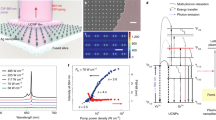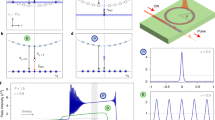Abstract
Periodic dielectric structures are typically integrated with a planar waveguide to create photonic band-edge modes for feedback in one-dimensional distributed feedback lasers and two-dimensional photonic-crystal lasers1,2,3,4. Although photonic band-edge lasers are widely used in optics and biological applications, drawbacks include low modulation speeds and diffraction-limited mode confinement5,6. In contrast, plasmonic nanolasers can support ultrafast dynamics and ultrasmall mode volumes7,8,9. However, because of the large momentum mismatch between their nanolocalized lasing fields and free-space light, they suffer from large radiative losses and lack beam directionality. Here, we report lasing action from band-edge lattice plasmons in arrays of plasmonic nanocavities in a homogeneous dielectric environment. We find that optically pumped, two-dimensional arrays of plasmonic Au or Ag nanoparticles surrounded by an organic gain medium show directional beam emission (divergence angle <1.5° and linewidth <1.3 nm) characteristic of lasing action in the far-field, and behave as arrays of nanoscale light sources in the near-field. Using a semi-quantum electromagnetic approach to simulate the active optical responses, we show that lasing is achieved through stimulated energy transfer from the gain to the band-edge lattice plasmons in the deep subwavelength vicinity of the individual nanoparticles. Using femtosecond-transient absorption spectroscopy, we verified that lattice plasmons in plasmonic nanoparticle arrays could reach a 200-fold enhancement of the spontaneous emission rate of the dye because of their large local density of optical states.
This is a preview of subscription content, access via your institution
Access options
Subscribe to this journal
Receive 12 print issues and online access
$259.00 per year
only $21.58 per issue
Buy this article
- Purchase on Springer Link
- Instant access to full article PDF
Prices may be subject to local taxes which are calculated during checkout





Similar content being viewed by others
References
Kogelnik, H. & Shank, C. V. Coupled-wave theory of distributed feedback lasers. J. Appl. Phys. 43, 2327–2335 (1972).
Meier, M. et al. Laser action from two-dimensional distributed feedback in photonic crystals. Appl. Phys. Lett. 74, 7–9 (1999).
Noda, S., Yokoyama, M., Imada, M., Chutinan, A. & Mochizuki, M. Polarization mode control of two-dimensional photonic crystal laser by unit cell structure design. Science 293, 1123–1125 (2001).
Matsubara, H. et al. GaN photonic-crystal surface-emitting laser at blue-violet wavelengths. Science 319, 445–447 (2008).
Altug, H., Englund, D. & Vuckovic, J. Ultrafast photonic crystal nanocavity laser. Nature Phys. 2, 484–488 (2006).
Englund, D., Atlug, H., Ellis, B. & Vuckovic, J. Ultrafast photonic crystal lasers. Laser Photon. Rev. 2, 264–274 (2008).
Noginov, M. A. et al. Demonstration of a spaser-based nanolaser. Nature 460, 1110–1168 (2009).
Oulton, R. F. et al. Plasmon lasers at deep subwavelength scale. Nature 461, 629–632 (2009).
Stockman, M. I. The spaser as a nanoscale quantum generator and ultrafast amplifier. J. Opt. 12, 024004 (2010).
Novotny, L. & Hecht, B. Principles of Nano-Optics (Cambridge Univ. Press, 2006).
Purcell, E. M. Spontaneous emission probabilities at radio frequencies. Phys. Rev. 69, 681 (1946).
Ma, R-M., Oulton, R. F., Sorger, V. J. & Zhang, X. Plasmon lasers: coherent light source at molecular scales. Laser Photon. Rev. 7, 1–21 (2012).
Maier, S. A. Plasmonics: Fundamentals and Applications (Springer, 2007).
Zou, S. L., Janel, N. & Schatz, G. C. Silver nanoparticle array structures that produce remarkably narrow plasmon lineshapes. J. Chem. Phys. 120, 10871–10875 (2004).
Auguie, B. & Barnes, W. L. Collective resonances in gold nanoparticle arrays. Phys. Rev. Lett. 101, 143902 (2008).
Chu, Y. Z., Schonbrun, E., Yang, T. & Crozier, K. B. Experimental observation of narrow surface plasmon resonances in gold nanoparticle arrays. Appl. Phys. Lett. 93, 181108 (2008).
Kravets, V. G., Schedin, F. & Grigorenko, A. N. Extremely narrow plasmon resonances based on diffraction coupling of localized plasmons in arrays of metallic nanoparticles. Phys. Rev. Lett. 101, 087403 (2008).
Vecchi, G., Giannini, V. & Rivas, J. G. Surface modes in plasmonic crystals induced by diffractive coupling of nanoantennas. Phys. Rev. B 80, 201401 (2009).
Zhou, W. & Odom, T. W. Tunable subradiant lattice plasmons by out-of-plane dipolar interactions. Nature Nanotech. 6, 423–427 (2011).
Zhou, W., Hua, Y., Huntington, M. D. & Odom, T. W. Delocalized lattice plasmon resonances show dispersive quality factors. J. Phys. Chem. Lett. 3, 1381–1385 (2012).
Loncar, M. et al. Experimental and theoretical confirmation of Bloch-mode light propagation in planar photonic crystal waveguides. Appl. Phys. Lett. 80, 1689–1691 (2002).
Baba, T. Slow light in photonic crystals. Nature Photon. 2, 465–473 (2008).
Vecchi, G., Giannini, V. & Rivas, J. G. Shaping the fluorescent emission by lattice resonances in plasmonic crystals of nanoantennas. Phys. Rev. Lett. 102, 146807 (2009).
Samuel, I. D. W., Namdas, E. B. & Turnbull, G. A. How to recognize lasing. Nature Photon. 3, 546–549 (2009).
Siegman, A. E. Lasers (University Science Books, 1986).
Samuel, I. D. W. & Turnbull, G. A. Organic semiconductor lasers. Chem. Rev. 107, 1272–1295 (2007).
Wang, D. L. et al. Investigation on photoexcited dynamics of IR-140 dye in ethanol by femtosecond supercontinuum-probing technique. J. Opt. A 4, 155–159 (2002).
Rurack, K. & Spieles, M. Fluorescence quantum yields of a series of red and near-infrared dyes emitting at 600–1000 nm. Anal. Chem. 83, 1232–1242 (2011).
Henzie, J., Lee, M. H. & Odom, T. W. Multiscale patterning of plasmonic metamaterials. Nature Nanotech. 2, 549–554 (2007).
Nagra, A. S. & York, R. A. FDTD analysis of wave propagation in nonlinear absorbing and gain media. IEEE Trans Antennas Propag. 46, 334–340 (1998).
Van Beijnum, F. et al. Surface plasmon lasing observed in metal hole arrays. Phys. Rev. Lett. 110, 206802 (2013).
Acknowledgements
This work was supported by the NSF-MRSEC program at the Materials Research Science and Engineering Center at Northwestern University (DMR-1121262; W.Z., J.Y.S., M.D., G.C.S., T.W.O.), the Initiative for Sustainability and Energy at Northwestern (ISEN) Faculty Booster Award (J.Y.S., C.H.K., D.T.C.) and the US Department of Energy (DOE), Office of Science, Office of Basic Energy Sciences (DE-SC0004752; M.D., G.C.S.). Transient absorption measurement and data analysis were supported as part of the ANSER Center, an Energy Frontier Research Center funded by the DOE (DE-SC0001059; D.T.C., M.R.W.).
Author information
Authors and Affiliations
Contributions
W.Z. and T.W.O. conceived the idea of a new surface-emitting laser based on strongly coupled plasmonic nanocavity arrays. W.Z. fabricated the devices, carried out the angle-resolved optical measurement, and performed FDTD numerical simulations of the passive optical responses of the devices. M.D. developed the numerical methods to simulate the active optical responses of the device. J.Y.S., C.H.K. and W.Z. carried out lasing and transient absorption measurements, and C.H.K. and D.T.C. set up the transient absorption measurements. T.W.O., G.C.S., D.T.C. and M.R.W. guided the experimental and theoretical investigations. W.Z. and T.W.O. analysed the data and wrote the manuscript.
Corresponding author
Ethics declarations
Competing interests
The authors declare no competing financial interests.
Supplementary information
Supplementary information
Supplementary information (PDF 2684 kb)
Rights and permissions
About this article
Cite this article
Zhou, W., Dridi, M., Suh, J. et al. Lasing action in strongly coupled plasmonic nanocavity arrays. Nature Nanotech 8, 506–511 (2013). https://doi.org/10.1038/nnano.2013.99
Received:
Accepted:
Published:
Issue Date:
DOI: https://doi.org/10.1038/nnano.2013.99
This article is cited by
-
Magnetic on–off switching of a plasmonic laser
Nature Photonics (2022)
-
Plasmonic lasers turn magnetic
Nature Photonics (2022)
-
Ultra-high-Q resonances in plasmonic metasurfaces
Nature Communications (2021)
-
An optic to replace space and its application towards ultra-thin imaging systems
Nature Communications (2021)
-
Sub-picosecond thermalization dynamics in condensation of strongly coupled lattice plasmons
Nature Communications (2020)



